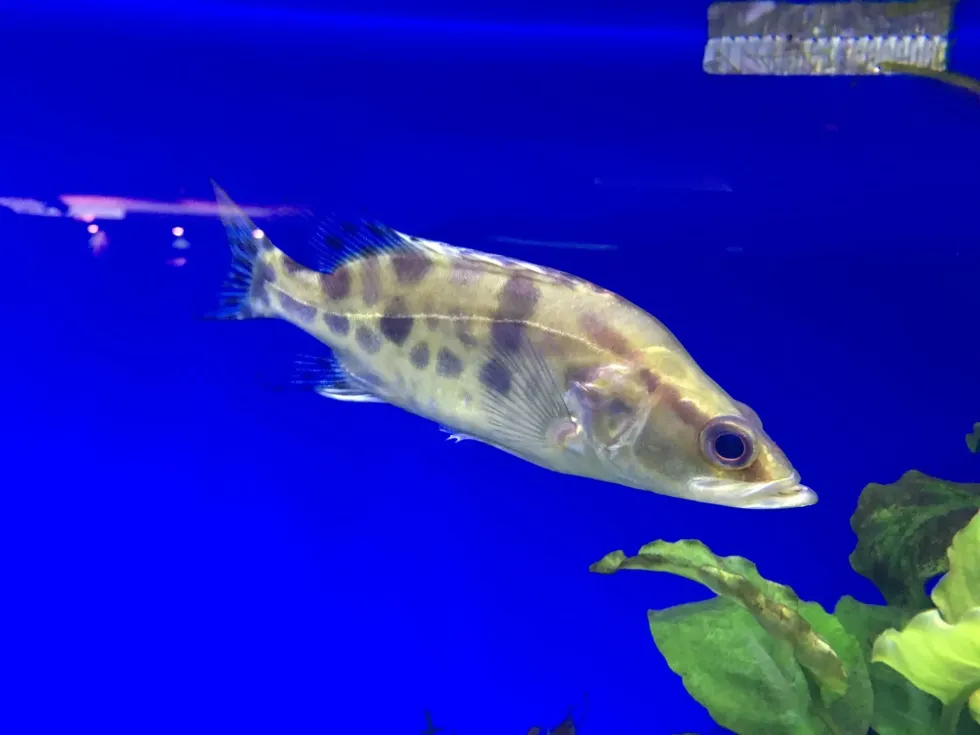In northern America, there are about 130 types of perch. The Chinese perch is a member of the Sinipercidae family.
The Chinese perch is known by its scientific name Siniperca chuatsi. They are also known by their other common names, Mandarin perch, Mandarin fish or Asian perch. Chinese perch (Siniperca chuatsi) is primarily a carnivorous fish and it feeds on smaller fishes and shrimp.
Chinese perch (Siniperca chuatsi) predominantly are bottom dwellers and seldom come to the surface of the water. They are freshwater fish and can also be kept in a fish tank as well.
Chinese perch (Siniperca chuatsi) is native to China and Vietnam but it is also spotted in the drainage basin of the Amur River. They are consumed by people in different parts of the world but specifically, in the range they are predominantly seen in.
This fish is a good source of various nutrients. If consumed in excessive amounts they can be harmful to the people who eat them. This mandarin fish is a popular pet fish as well.
For more relatable content, check out our articles on the sandperch and Nile perch.
Chinese Perch Interesting Facts
What type of animal is a Chinese perch?
The Chinese perch is a type of fish that belongs to the kingdom Animalia, order Perciformes, and genus Siniperca.
What class of animal does a Chinese perch belong to?
The Chinese perch (Siniperca chuatsi) is a type of fish that belongs to the class Actinopterygii, family Sinipercidae, and genus Siniperca.
How many Chinese perches are there in the world?
The exact population of Chinese perch (Siniperca chuatsi) in the world is not known. The Devil's hole pupfish is the rarest fish in the world and their population dropped to only 35 in 2013.
Where does a Chinese perch live?
Chinese perch (Siniperca chuatsi) live in tanks, lakes, and rivers. They are native to and seen in the Amur river basin, China, and Vietnam. They are territorial beings and can become territorial in a tank as well as while feeding. It is essential to keep them in large tanks as in the wild, they compete for food.
What is a Chinese perch's habitat?
The Chinese perch (Siniperca chuatsi) habitat includes rivers and lakes. They survive best in freshwater bodies and are rarely seen in any other habitat. The Chinese perch (Siniperca chuatsi) is rarely adopted as a pet.
Who do Chinese perches live with?
Chinese perch are bottom dwellers and the adults are mostly solitary creatures. They come together only during mating season. Siniperca chuatsi can be aggressive and territorial and are best kept solely or with ample space.
They can be kept with a goldfish provided there is enough species in the tank. Chinese perches are region-specific species so it is rare to find them kept as pets. Other perch species are more commonly kept as pets.
How long does a Chinese perch live?
The exact lifespan of this fish species is not known. The oldest fish in the world is a female Greenland shark who was estimated to have lived up to 400 years.
How do they reproduce?
Chinese perch reproduce similar to other perch fish. During the breeding season, the eggs fertilize externally through external fertilization. The female Chinese perch lays the eggs in a strand. Females are known to lay close to 4000 eggs or more. The male sperm is produced by the testes and they mate multiple times throughout their life.
What is their conservation status?
Chinese perch is classified with the conservation status of Not Evaluated by the International Union For Conservation Of Nature IUCN Red List Of Threatened species.
Chinese Perch Fun Facts
What do Chinese perch look like?
The Chinese perch fish is a medium to large-sized fish with a compressed body and a protruding jaw. Their jaw consists of saw-like teeth with four to five sharp rays.
Their jaw is placed inside their mouth and they use their mouth to feed on food. Siniperca chuatsi have two dark-colored eyes on either side of their face. Their prey is detected using these two big eyes.
Their eyes help them detect light which is invisible to the human eye. Siniperca chuatsi have an overall shiny brownish-yellow body with certain spots and other blotches.
Siniperca chuatsi have multiple fins including their dorsal fins and its front part contains hard spines. Their dorsal fin is rounded.
Their anal, caudal, and pectoral fins are rounded. Siniperca chuatsi can be spotted easily on the bottom levels of the water or tank if kept as a pet. They have a streamlined body that eases their body movements which are assisted by their dorsal, pectoral, and other fins.

* Please note that this image is of a yellow perch, not of a Chinese perch. If you have an image of a Chinese perch, please let us know at hello@kidadl.com
How cute are they?
The Chinese perch (Siniperca chuatsi) is not ideally a cute fish and can be aggressive and territorial. However, they are exotic fish feeding on the bottom levels of the water or tank.
Their fins including the dorsal, anal, and other fins set them apart from other species. They are an important part of Chinese history hence they are popular and common in China.
How do they communicate?
The Chinese perch (Siniperca chautsi) communicates in a similar way to other fish using sound, color, electrical impulse, and smell. The sound which fishes use to communicate is not audible to humans.
How big is a Chinese perch?
The Chinese perch (Siniperca chautsi) is 28 in (70 cm) large in length and is bigger than the dwarf minnow, one of the smallest fish measuring 0.40 in (10.3 mm) in size.
How fast can a Chinese perch swim?
A Chinese perch's (Siniperca chautsi) exact swimming speed is not known. Chinese perch (Siniperca chautsi) dwell in the bottom levels of the water.
How much does a Chinese perch weigh?
Chinese perches (Siniperca chautsi) weigh 18 lb (8 kg). The whale shark is the heaviest fish in the world weighing the highest among all fishes.
What are thei male and female names of the species?
Male and female Chinese perch are not addressed differently. A Siniperca chuatsi male and female look similar in appearance, however they differ in reproductive functions.
What would you call a baby Chinese perch?
A baby Chinese perch is called a fry. Females lay multiple eggs per clutch and are fertilized externally. Chinese perch fry (Siniperca chuatsi) develop and grow individually. Parents are not involved in raising the young.
What do they eat?
Chinese perch (Siniperca chautsi) is a carnivorous fish. Chinese perch (Siniperca chautsi) feed on small fish and shrimp as food and prey. Chinese perch (Siniperca chautsi) are ambush predators and feeding may occur multiple times throughout the day.
Feeding perch pets excess amounts of food can be detrimental to their health. Pet perch fishes are fed dried shrimp as food during different intervals of the day. They find it easy to feed on prey using the teeth built into their mouth.
Are they dangerous?
Chinese perch (Siniperca chautsi) are not dangerous towards humans. Other types of perch are also kept as pets by fish pet owners.
Siniperca chuatsi is also consumed in some parts of the world however, if they are consumed in excess amount, this fish can be harmful. They cannot be placed in tanks with smaller fishes since they might instantaneously attack the latter.
Would they make a good pet?
Chinese perch (Siniperca chautsi) are seldom seen adopted as pets. The Chinese perch is a carnivorous fish that is endemic to a specific place.
Perch fishes are adopted as pets by owners however it's best to keep them in tanks with similar species. Keeping smaller fish along with them can be harmful to the smaller fish.
Chinese perch (Siniperca chuatsi) need to be fed timely, and it's essential that there is a functioning filter that circulates water regularly since they cannot survive in saline or polluted water for long. You could consider keeping perch fishes in open tanks with certain closures to secure the tank with water.
They can also be seen raised in fish farms where people create a habitat for such aquatic fishes in order to sell them for consumption purposes. Aquatic fishes caught from the natural water body are better compared to those raised on a farm.
Although you might not be able to adopt a Chinese perch, you can adopt other species of perch or pet fishes that are endemic to your region.
Did you know...
There are over 30,000 species of fish in the world. The most diversification and range in any species of animals exists in fishes.
Almost one trillion fish are collected each year from water bodies for human consumption. Some of them are sent through processing to fisheries around the world and some are consumed indigenously. Processing involves examining their quality and inspecting them for any defects.
Jellyfish, starfish and crayfish aren't really fish although they live in deep waters or similar regions as fishes.
Certain fish adopted as pets are capable of recognizing their owners and also enjoy socializing with them. They are not considered fun pets however, they are ideal for a first-time owner.
The mandarin fish is a colorful fish, however mandarin fish are poisonous to consume. This fish is known for its foul-tasting odorous mucous it produces. Mandarin fish are consumed in certain parts of the world. The Chinese perch is often referred to as the Mandarin perch however it's different from the Mandarin fish.
Does the perch come from China?
The perch fish is seen in different parts of the world. The Chinese perch (Siniperca chautsi) is seen in China and Vietnam as well as in the region near the Amur River.
Chinese perch (Siniperca chuatsi) fish are seldom seen outside their range or territory and are consumed by people in the range they are endemic to. The Chinese perch (Siniperca chuatsi) is native to China. Other fish in this area include white cloud mountain minnow, carp fishes, and other fish breeds.
Why are perch called perch?
The word 'perch' comes from the Greek word 'perke', meaning 'perch' and the Latin word 'forma', meaning 'shape'. Chinese perch (Siniperca chuatsi) and other similar fish are seen in different parts of the world.
Other fish include the sandperch and Nile perch. Chinese perch (Siniperca chuatsi) are often confused with sunfish however they are a completely separate species and belong to a different range and territory.
Here at Kidadl, we have carefully created lots of interesting family-friendly animal facts for everyone to discover! Learn more about some other fish from our port Jackson shark facts and coho salmon facts pages.
You can even occupy yourself at home by coloring in one of our free printable Chinese perch coloring pages.










